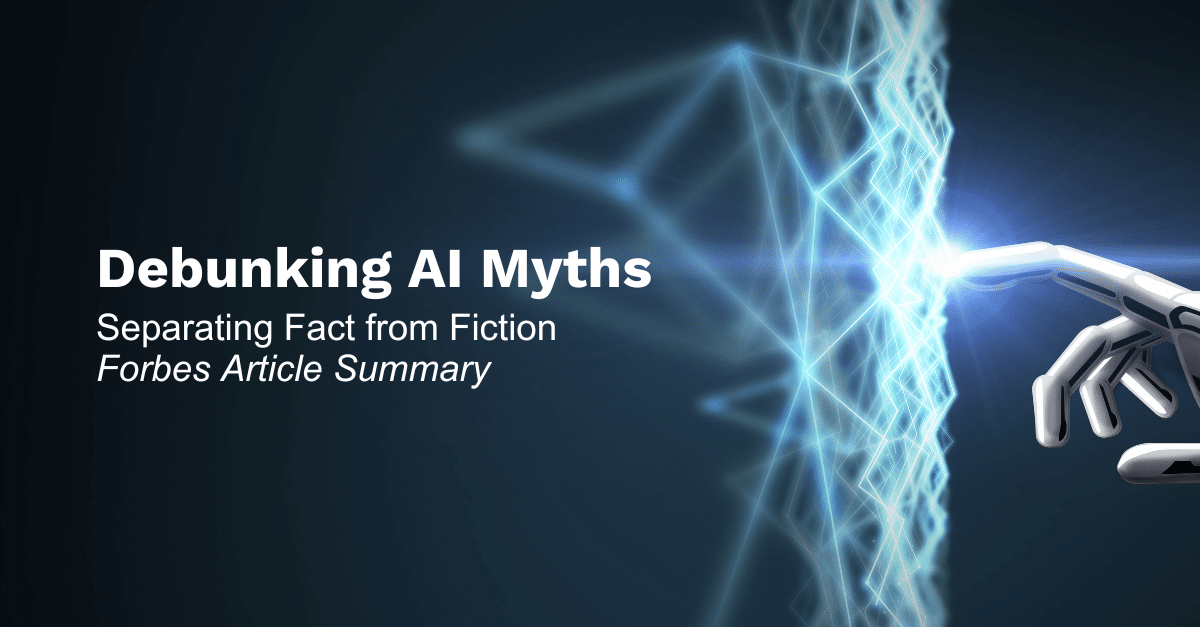Debunking The Myths: What AI Can (and Can't) Do

Table of Contents
AI Can Automate Repetitive Tasks
Increased Efficiency and Productivity
AI excels at automating repetitive, data-driven tasks, freeing up human workers for more complex and creative endeavors. This automation significantly boosts efficiency and productivity across various sectors.
- Example: Automating customer service inquiries through chatbots, streamlining data entry processes, and optimizing basic manufacturing processes through robotic process automation (RPA).
- Benefits: Reduced operational costs, increased speed and accuracy, improved employee satisfaction leading to higher retention rates, and the ability to handle larger volumes of work. This allows businesses to focus on strategic initiatives rather than mundane tasks.
Limitations of Current AI Automation
While AI can automate many tasks, it struggles with tasks requiring nuanced human judgment, creativity, and adaptability. The complexity of truly human-like understanding remains a significant hurdle.
- Example: Complex negotiations requiring emotional intelligence, artistic creation demanding originality and imagination, and tasks involving significant improvisation or problem-solving in unpredictable environments.
- Note: AI automation is best suited for well-defined, structured tasks with large, readily available datasets. The data needs to be clean and appropriately labeled for effective machine learning.
AI Can Analyze Data and Identify Patterns
Data-Driven Insights and Predictions
AI algorithms excel at analyzing vast amounts of data to identify patterns and trends invisible to human analysts. This capability unlocks powerful predictive capabilities and data-driven decision-making.
- Example: Fraud detection in financial transactions, assisting in medical diagnosis by analyzing medical images, predicting market trends for informed investment strategies, and providing personalized recommendations in e-commerce.
- Benefits: Improved decision-making based on objective analysis, enhanced accuracy in predictions leading to better risk management, and the discovery of hidden correlations that might otherwise be missed.
Data Quality and Bias Concerns
The accuracy of AI-driven insights depends heavily on the quality and representativeness of the data used to train the algorithms. Bias in data can lead to skewed, unfair, and inaccurate results.
- Example: Biased algorithms in facial recognition systems leading to misidentification, algorithmic bias in loan applications resulting in discriminatory outcomes, and similar biases in hiring processes.
- Note: Addressing data bias is crucial for ensuring fairness and accuracy in AI applications. Careful data curation, rigorous testing, and ongoing monitoring are essential steps in mitigating bias and ensuring responsible AI development.
AI Cannot Think or Feel Like Humans
The Difference Between Artificial and Human Intelligence
Current AI systems are narrow or weak AI, designed for specific tasks. They lack the general intelligence, consciousness, and emotional capacity of humans. This is a fundamental distinction that needs clarification.
- Example: AI can beat humans at chess, but it cannot understand the complex social dynamics or emotional nuances of a human relationship. It excels at a specific task, but lacks general understanding.
- Misconception: The portrayal of sentient AI in science fiction often misrepresents current technological capabilities. This fuels unrealistic expectations and can lead to misunderstandings of AI's true potential.
Ethical Considerations of Advanced AI
The development of Artificial General Intelligence (AGI) raises significant ethical questions about consciousness, autonomy, and potential risks. These are complex issues that require careful consideration.
- Example: Concerns about widespread job displacement due to automation, the amplification of existing societal biases through algorithmic decision-making, and the potential misuse of advanced AI for malicious purposes.
- Note: Open discussions, interdisciplinary collaboration, and responsible development are essential to mitigate potential risks and ensure the ethical use of AI.
AI Requires Human Oversight and Collaboration
The Human-in-the-Loop Approach
AI systems are most effective when used collaboratively with humans. Human oversight is essential to ensure accuracy, address biases, and make ethical decisions. This collaborative approach is crucial for responsible AI development and deployment.
- Example: Doctors using AI diagnostic tools to aid in decision-making but retaining ultimate responsibility for patient care, engineers monitoring AI-controlled manufacturing processes and intervening when necessary.
- Benefits: Improved accuracy through human verification, enhanced decision-making that combines human intuition with AI's analytical capabilities, and greater accountability for AI's actions.
The Importance of Human Expertise
AI is a tool that augments human capabilities, not replaces them. Human expertise remains essential for defining problems, interpreting results, and ensuring responsible AI development. The human element is irreplaceable.
- Example: Data scientists training and validating AI models to ensure their accuracy and reliability, human editors reviewing AI-generated content to ensure quality and accuracy, and subject matter experts providing context and guidance for AI systems.
- Note: The future of AI relies on human-AI partnerships, combining the strengths of both human intelligence and artificial intelligence for optimal results.
Conclusion
AI is a powerful technology with the potential to revolutionize many aspects of our lives. However, understanding its limitations is as crucial as recognizing its capabilities. By debunking the myths surrounding AI, we can foster more realistic expectations and ensure its responsible development and deployment. Avoid falling for the hype; instead, focus on how to effectively leverage the real capabilities of AI for positive impact. Learn more about responsible AI development and explore how to integrate AI solutions effectively into your workflow. Let's work together to harness the true potential of AI and build a future where AI benefits all of humanity.

Featured Posts
-
 Us Attorney Generals Warning To Minnesota Compliance With Trumps Transgender Athlete Ban
Apr 29, 2025
Us Attorney Generals Warning To Minnesota Compliance With Trumps Transgender Athlete Ban
Apr 29, 2025 -
 Nyt Spelling Bee Answers And Clues April 27 2025
Apr 29, 2025
Nyt Spelling Bee Answers And Clues April 27 2025
Apr 29, 2025 -
 Spain Vs Usa A Tale Of Two American Expats Experiences
Apr 29, 2025
Spain Vs Usa A Tale Of Two American Expats Experiences
Apr 29, 2025 -
 Jeff Goldblum And The Mildred Snitzer Orchestras I Dont Know Why I Just Do Featuring Ariana Grande A Musical Collaboration
Apr 29, 2025
Jeff Goldblum And The Mildred Snitzer Orchestras I Dont Know Why I Just Do Featuring Ariana Grande A Musical Collaboration
Apr 29, 2025 -
 Get Capital Summertime Ball 2025 Tickets A Comprehensive Guide For Fans
Apr 29, 2025
Get Capital Summertime Ball 2025 Tickets A Comprehensive Guide For Fans
Apr 29, 2025
Latest Posts
-
 76ers Sufren Novena Derrota Anunoby Anota 27 Para Los Knicks
May 12, 2025
76ers Sufren Novena Derrota Anunoby Anota 27 Para Los Knicks
May 12, 2025 -
 Anunoby Lidera A Knicks Con 27 Puntos En Victoria Sobre 76ers
May 12, 2025
Anunoby Lidera A Knicks Con 27 Puntos En Victoria Sobre 76ers
May 12, 2025 -
 Anunoby Anota 27 Knicks Vencen A Sixers En Emocionante Partido
May 12, 2025
Anunoby Anota 27 Knicks Vencen A Sixers En Emocionante Partido
May 12, 2025 -
 Magic Johnsons Expert Analysis Who Wins The Knicks Pistons Matchup
May 12, 2025
Magic Johnsons Expert Analysis Who Wins The Knicks Pistons Matchup
May 12, 2025 -
 Nba Playoffs Magic Johnson Weighs In On Knicks Pistons Series
May 12, 2025
Nba Playoffs Magic Johnson Weighs In On Knicks Pistons Series
May 12, 2025
